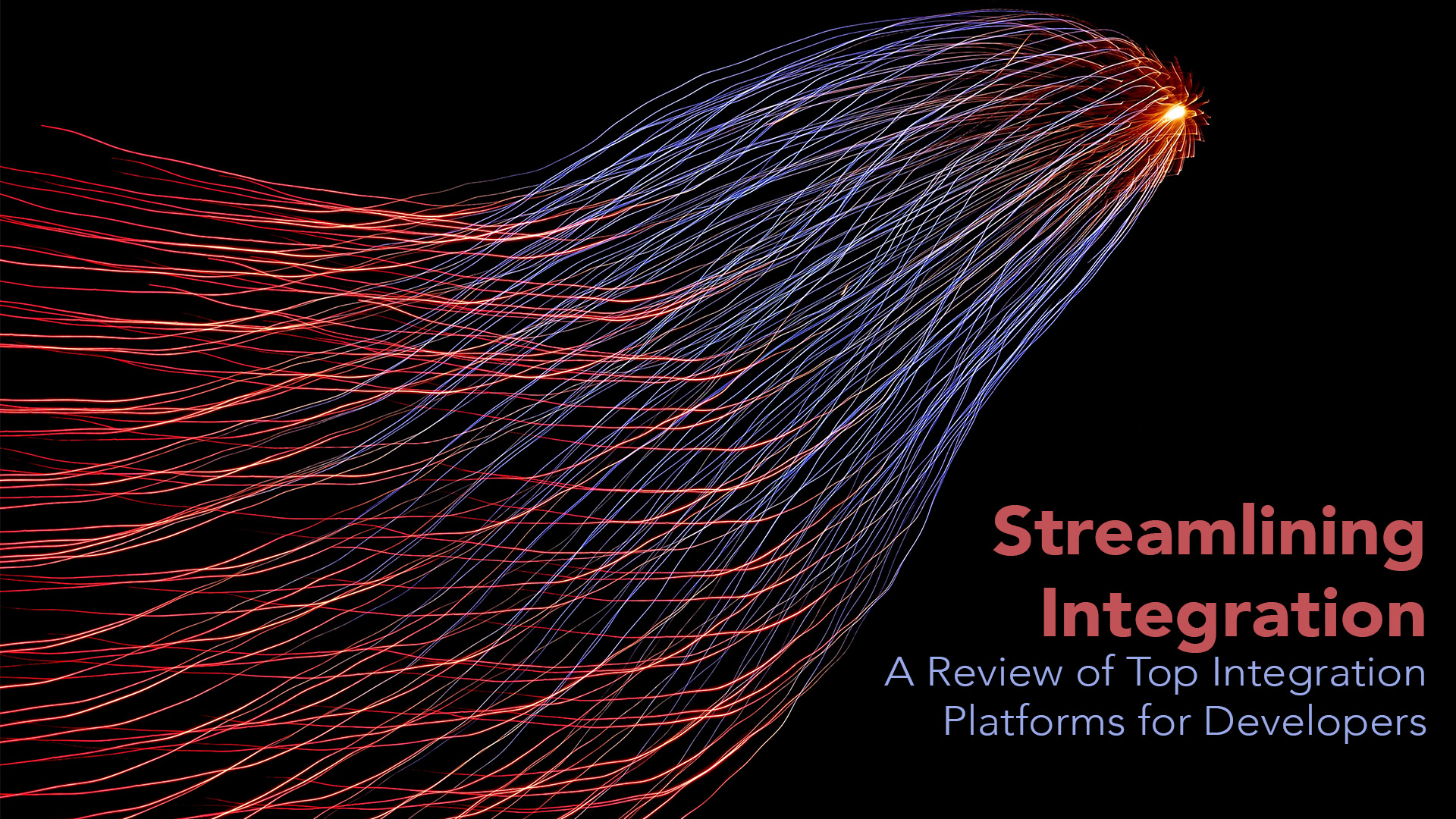Published by
Have you been longing for a way to liberate yourself from the monotonous and repetitive grunt work that accompanies the task of moving data from point A to B within your applications? Wouldn’t it be marvelous if you could bypass the hundredth episode (feature) of connecting a downstream API request to numerous upstream API requests? If these thoughts resonate with you, then you’ve come to the right place.
Throughout the captivating journey of this article, we will delve into a few iPaaS (Integration Platform as a Service) options that have emerged to rescue developers from the arduous and time-consuming process of integration. Our aim is to provide you with an overview of the available options that can alleviate the pain and enhance the efficiency of integration in your projects.
It’s worth mentioning that this article does not attempt to engage in a conventional “pros vs. cons” debate, as you can easily find such comparisons scattered across the vast expanse of the internet. Instead, we embark on a candid exploration, drawing upon our collective experiences using various integration tools. Prepare yourself for unfiltered and authentic insights as we unravel the options that lie before us.
Let’s dig in.
MuleSoft Anypoint Platform
To start, let’s discuss one of the most well-known and respected options in the iPaaS space. MuleSoft has been named one of the leaders in iPaaS many times over. It’s one of the most well-equipped platforms in terms of features which include:
- Studio — a desktop IDE for integration and API implementation where development happens largely via drag-and-drop components (low-code)
- Designer — visual or code-based API designer
- Exchange — hosts published APIs and assets which enables API discovery for consumers
- Runtime Manager — provides deployment, management, and observability functions for applications across environments
- API Manager — provides API management and gateway capabilities
All these features and more work in harmony, which enables developers to quickly deploy their integration projects. The Anypoint Platform doesn’t just cover integration. In fact, Anypoint Platform will support developers even before implementation begins with API design and discoverability features. Anypoint enables an API Design-First approach which tugs at our heart strings here at Bottle Rocket. All these features and overall convenience of the platform will leave developers developing in luxury. By luxury we mean access to about 200 pre-built connectors which can integrate with a plethora of common services and technologies such as HTTP, RDBMS, Salesforce and many others. With all these options, we dubbed MuleSoft the “Cadillac of Integration.” Much like the vehicle will leave you riding in comfort and with convenience, MuleSoft provides full API lifecycle management capabilities for use at your convenience.
The added comfort and convenience of a platform like MuleSoft is not for everything though. Taking turns at 10 to 20 mph is possible all day long with the classically soft suspension of The Cadillac. However, taking turns at 30mph plus might lead to a difficult day at the track (the office). Your organization’s most important intellectual property (IP) systems and performance-intensive applications should not be developed on MuleSoft. MuleSoft does not seek to replace your backend, proprietary systems, but rather acts as an enabler to make your system’s valuable data and features accessible to others. As engineers responsible for maintaining these critical systems, you can leverage MuleSoft’s “API-led connectivity” concepts to unlock the potential of your backend systems and extend their reach beyond their immediate boundaries. The API-led philosophy, not any specific feature or product, is what us API Integration engineers here at Bottle Rocket like the most about the platform. It is an enjoyable experience to start out with a plan in the form of API specifications and have the support of an ironclad integration platform doing all the right things to help you deliver the implementation.
Boomi
If you find the low-code form of development appealing, you might be right at home in Boomi’s atmosphere, the Boomi AtmoSphere Platform. Boomi is another well-respected option in the iPaaS space. Boomi has been at top of the integration game for longer than most of the competitors. The oldest iPaaS according to Boomi, “The first iPaaS was launched by Boomi in 20081.” Here is some of the services:
- Integration — a web-based, low-code integration process builder complete with deployment and management functions
- Master Data Hub (MDH) — a master data management solution that offers a low-code data mastering experience
- API Management — a companion to the Integration service that offers full lifecycle API management with the ability to create, publish and manage APIs
- EDI Management — provides B2B integration capabilities with trading partners using EDI
Everything orbits around the Integration service in Boomi. API Management can be used to expose APIs implemented as processes in the Integration service and the very same process could push data into Master Data Hub. The Integration service is the central piece that is consuming data and pushing it out to other sources. Integration is the name of the game for the Boomi platform and serves as a great option for processing enterprise data in general.
Boomi is no slouch when it comes to pre-built connectors either. Through Boomi’s multitude of application and technology specific connectors, it’s super easy to integrate with all your existing systems with minimum configuration straight out of the box. All integration process development is done using a low-code process editor. Low-code is keeping it modest as most of the time you will be rocketing towards an implementation without any code at all (no-code). Complex data mapping between resources, known as “Documents” in Boomi, can be easily achieved through a user-friendly, no-code experience. Another noteworthy aspect of the Integration service is its end-to-end approach, ensuring that the entire implementation lifecycle is efficiently managed within the platform. This comprehensive system enables seamless data mapping between resources and provides a user-friendly, no-code experience. In developer terms, this implies that there’s no requirement to be concerned about setting up a git repository or constructing a CI/CD pipeline. If you are seeking to swiftly build an integration process without being burdened by additional considerations, Boomi’s Integration service is an ideal choice.
Apache Camel
Let’s take a moment to address the notion of low-code… or should I say, schmo-code? While the low-code option may have its merits, it’s important to acknowledge that it may not be the perfect fit for every project. If you find yourself working on an existing project or if you’re simply inclined to take the high-code road (pun intended), then casting a discerning eye towards Apache Camel should be at the top of your list. Its prowess and flexibility in the realm of custom integration are not to be underestimated. Apache Camel’s origin story starts as an open-source integration framework written in Java. This O.G. version of Apache Camel is known as Camel Core and is the recipient of a ton of contributions from generous open-source contributors. We consider this to be one of the more noble efforts in open-source. Apache Camel is a little bit of an outlier in this roundup since it is not a platform per se. Instead, Apache Camel is the framework that one could build an iPaaS on — the work horse camel executing the integration processes. A Java framework is not proper these days without Spring Boot of course, so there is a Spring Boot-ified extension as well.
If your development operations don’t include Java (or the JVM to be more general), Apache Camel can still be in your future thanks to Camel K which is a more recent flavor of Camel that runs natively on Kubernetes. Here’s a complete list of Apache Camel usage options and some impressive highlights about Apache Camel in general:
- Standalone framework — can be embedded and run anywhere
- Components galore — 26 “core” components forming a solid integration foundation and 300+ additional components to integrate with just about anything under the sun
- Formats galore — support for about 50 data formats including JSON, XML and even the super cryptic HL7 format for electronic health records
When faced with these numbers, you might envision an Enterprise Service Bus (ESB) lurking beneath the surface, but that assumption would be amiss. Instead, the acronym you should be seeking is EIP, which stands for Enterprise Integration Patterns. Back in the day, around 2003, a brilliant group of minds gathered to pen the book aptly titled “Enterprise Integration Patterns” by Gregor Hohpe and Bobby Woolf. These authors, accompanied by a talented team of contributors, embarked on an exploration of the diverse integration design patterns prevalent in the wild. They skillfully distilled these patterns down to their quintessential essence, unveiling an astonishing revelation: there existed approximately 65 unique ways to seamlessly integrate with systems.
It is safe to say that Apache Camel is based on SCIENCE! The scientific bedrock and abundance of support has made Apache Camel the go to option for custom integration projects here at Bottle Rocket.
Conclusion
In today’s interconnected digital landscape, seamless integration of disparate systems and applications has become a critical challenge for businesses. Fortunately, there is a wide array of Integration Platforms as a Service (iPaaS) available, each offering its own unique set of features and capabilities. In this article, we have explored three prominent options: MuleSoft, Boomi, and Apache Camel.
MuleSoft stands out as a robust and comprehensive iPaaS solution, offering a powerful set of tools and a rich ecosystem that empowers engineers to build scalable integrations with ease. Its visual development environment, extensive library of connectors, and emphasis on API-led connectivity make it a popular choice for organizations of all sizes.
Boomi, on the other hand, shines with its simplicity and ease of use. With a low-code approach and a vast range of pre-built connectors, Boomi enables engineers to rapidly create integrations without extensive coding knowledge. Its cloud-native architecture and strong emphasis on data governance and security make it a reliable option for organizations that prioritize agility and compliance.
For those looking to have more control over their integration layer and customize it to their specific needs, Apache Camel emerges as an intriguing alternative. With its lightweight framework and extensive integration capabilities, Apache Camel allows engineers to build and run their own integration layer, tailored precisely to their requirements.
Regardless of the chosen iPaaS solution, the overarching goal remains the same — to streamline integration processes, foster data flow across systems, and enable businesses to focus on their core objectives. With the right iPaaS in place, engineers can alleviate the complexities of integration, empowering organizations to embrace digital transformation and thrive in an increasingly interconnected world.




